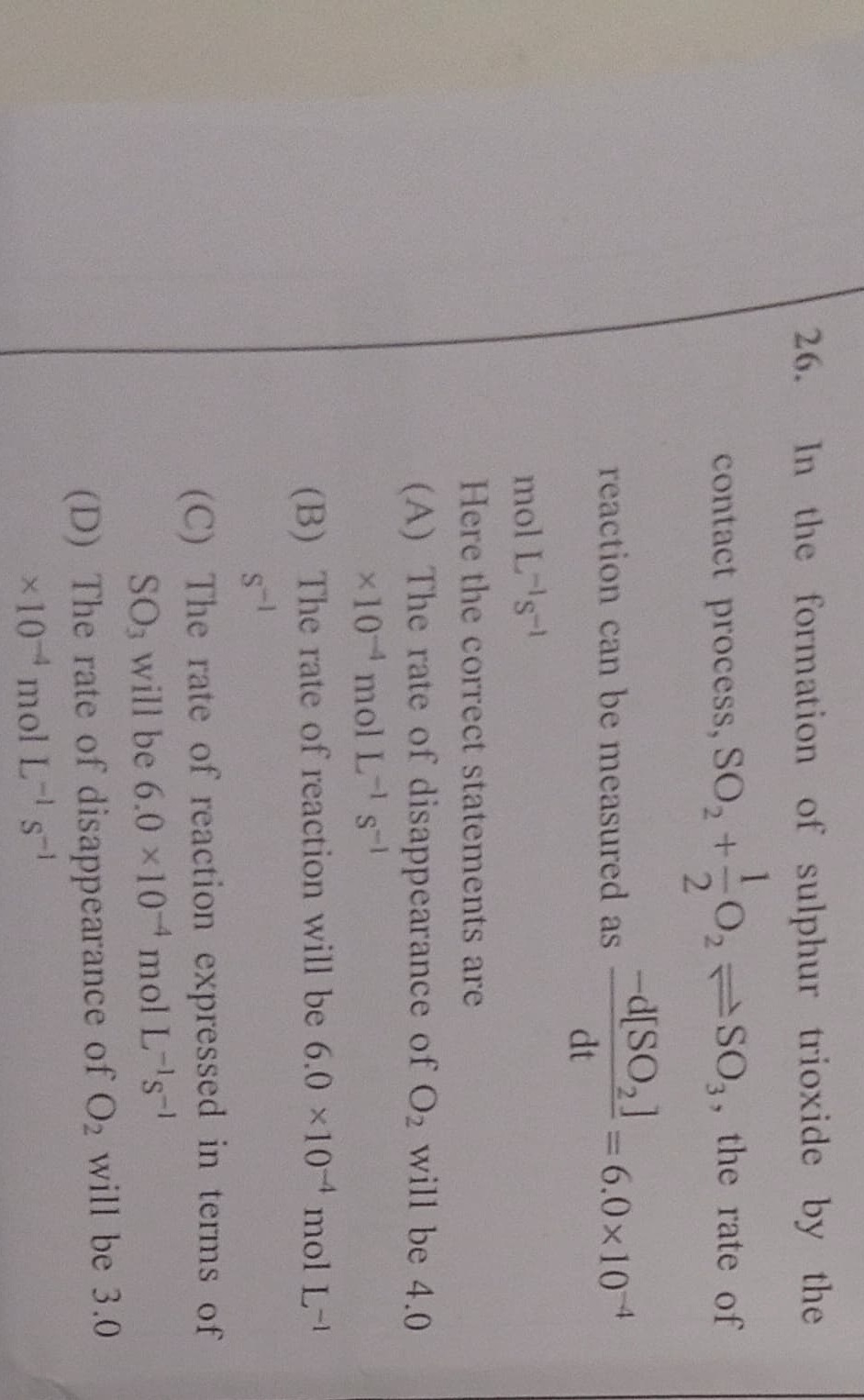Question
Question: In the formation of sulphur trioxide by the contact process, $SO_2 + \frac{1}{2}O_2 \rightleftharpoo...
In the formation of sulphur trioxide by the contact process, SO2+21O2⇌SO3, the rate of reaction can be measured as dt−d[SO2]=6.0×10−4 mol L−1s−1 Here the correct statements are

The rate of disappearance of O2 will be 4.0 ×10−4 mol L−1s−1
The rate of reaction will be 6.0 ×10−4 mol L−1s−1
The rate of reaction expressed in terms of SO3 will be 6.0 ×10−4 mol L−1s−1
The rate of disappearance of O2 will be 3.0 ×10−4 mol L−1s−1
B, C, D
Solution
The given reaction is:
SO2+21O2⇌SO3
The general expression for the rate of reaction for a balanced chemical equation aA+bB⇌cC+dD is:
Rate =−a1dtd[A]=−b1dtd[B]=+c1dtd[C]=+d1dtd[D]
Applying this to the given reaction:
Rate =−11dtd[SO2]=−1/21dtd[O2]=+11dtd[SO3]
Rate =−dtd[SO2]=−2dtd[O2]=+dtd[SO3]
We are given that the rate of disappearance of SO2 is dt−d[SO2]=6.0×10−4 mol L−1s−1.
Now let's evaluate each statement:
(A) The rate of disappearance of O2 will be 4.0 ×10−4 mol L−1s−1
From the rate expression, we have:
−dtd[SO2]=−2dtd[O2]
Given dt−d[SO2]=6.0×10−4 mol L−1s−1.
So, 6.0×10−4=2×(−dtd[O2])
The rate of disappearance of O2 is −dtd[O2].
−dtd[O2]=26.0×10−4=3.0×10−4 mol L−1s−1.
Therefore, statement (A) is incorrect.
(B) The rate of reaction will be 6.0 ×10−4 mol L−1s−1
By definition, the rate of reaction R=−dtd[SO2].
Given −dtd[SO2]=6.0×10−4 mol L−1s−1.
So, the rate of reaction is 6.0×10−4 mol L−1s−1.
Therefore, statement (B) is correct.
(C) The rate of reaction expressed in terms of SO3 will be 6.0 ×10−4 mol L−1s−1
From the rate expression, the rate of reaction R=+dtd[SO3].
Since R=6.0×10−4 mol L−1s−1 (from statement B), then dtd[SO3]=6.0×10−4 mol L−1s−1.
This means the rate of formation of SO3 is 6.0×10−4 mol L−1s−1. The statement refers to the rate of reaction expressed in terms of SO3, which implies the rate of formation of SO3.
Therefore, statement (C) is correct.
(D) The rate of disappearance of O2 will be 3.0 ×10−4 mol L−1s−1
As calculated in the evaluation of statement (A), the rate of disappearance of O2 (−dtd[O2]) is 3.0×10−4 mol L−1s−1.
Therefore, statement (D) is correct.
The correct statements are (B), (C), and (D).
